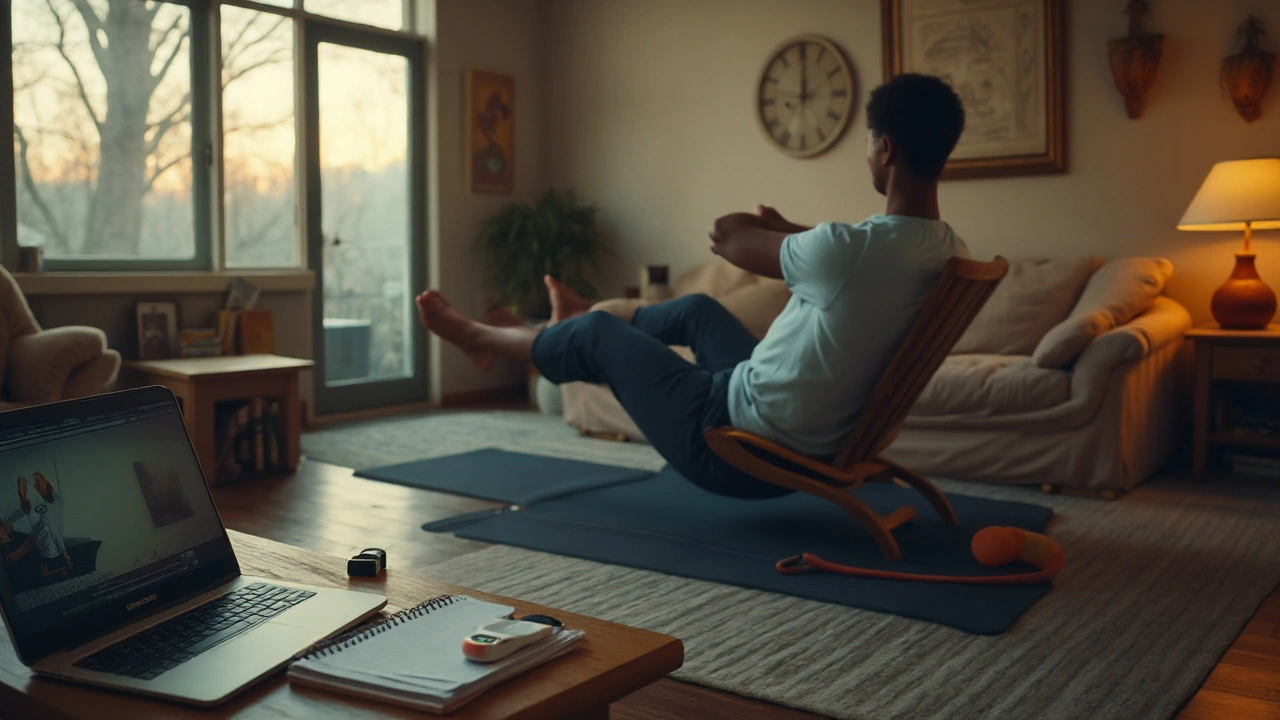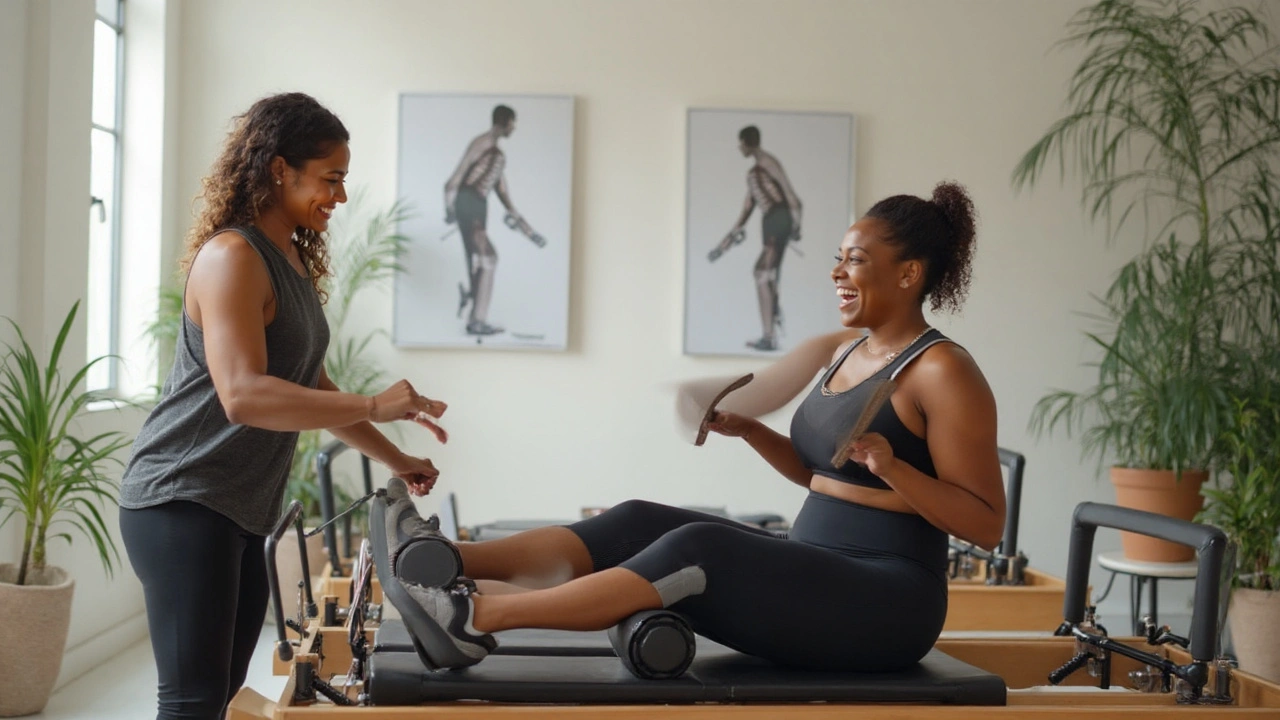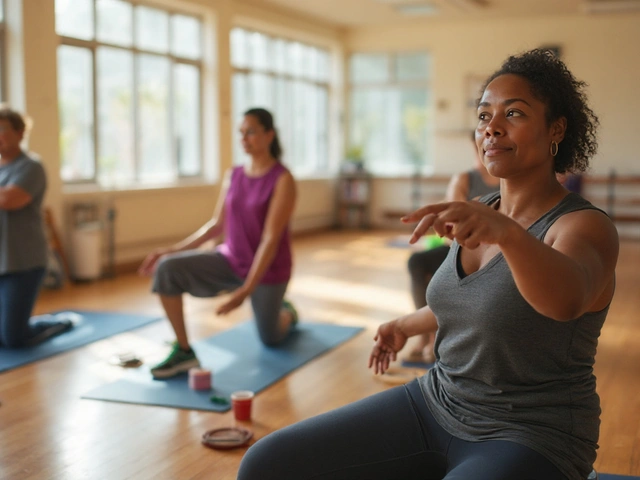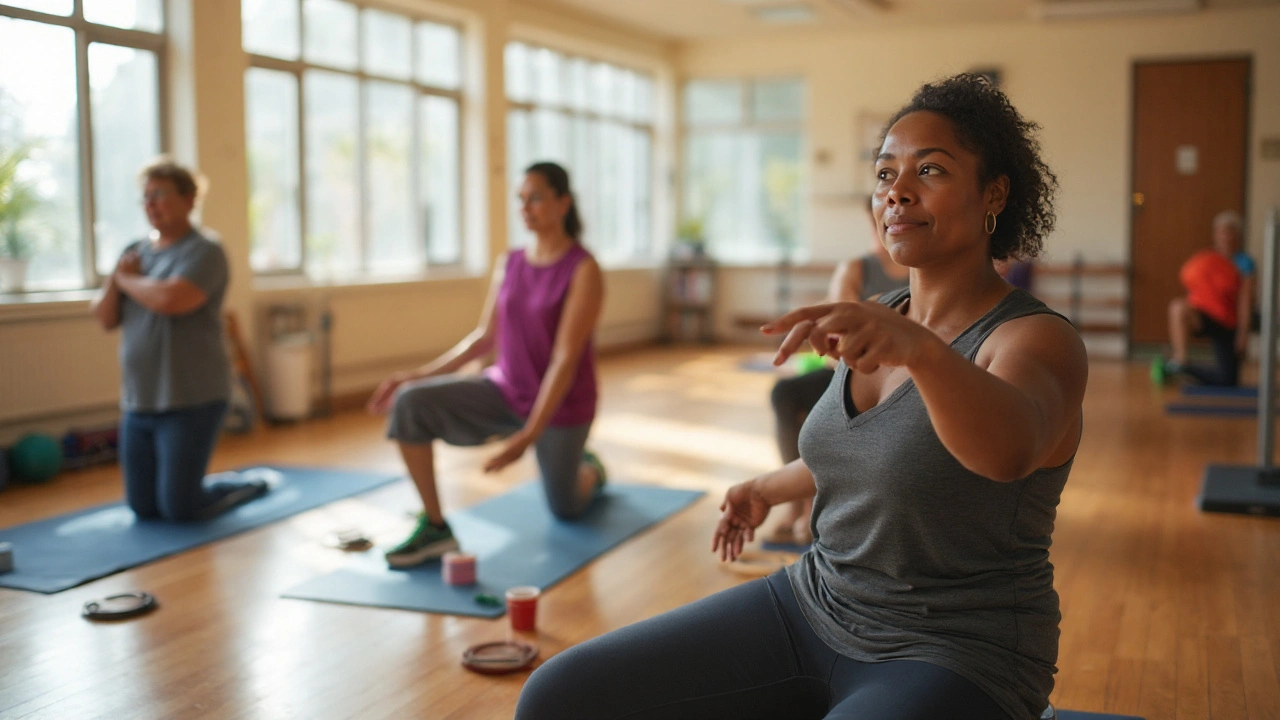Type 2 diabetes management isn’t just about food and meds. Movement changes the way your body handles glucose-sometimes within a single session. Pilates is a gentle way to train strength, mobility, and control without pounding your joints. It won’t replace your medication or your walking habit, but it can help lower glucose swings, improve insulin sensitivity, and make everyday life feel easier. Here’s a practical, evidence-backed guide so you can use Pilates to support your diabetes plan safely and effectively.
- TL;DR: Pilates can modestly lower HbA1c and fasting glucose, improve insulin sensitivity, and reduce waist size and blood pressure when done 2-3 times weekly for 8-12 weeks.
- Keep your aerobic baseline (e.g., brisk walking) and add Pilates 2-3 days/week; this counts toward resistance and balance work.
- Best practice: check glucose pre-session, time sessions 1-2 hours after a meal, and carry fast-acting carbs if you use insulin or sulfonylureas.
- Modify moves if you have retinopathy, neuropathy, or high blood pressure; avoid breath-holding and deep inversions.
- Track: pre/post glucose, weekly minutes, RPE (effort), and how you feel. Small, steady changes beat perfect plans.
Why Pilates helps with Type 2 diabetes: what changes in your body and what the evidence shows
Pilates for Type 2 Diabetes sits in a sweet spot: low-impact, strength-focused, and mindful. It builds lean muscle and improves neuromuscular control. More active muscle pulls more glucose from your bloodstream during and after sessions (via GLUT-4 transport), which can improve insulin sensitivity for hours-sometimes up to 24-48 hours after a solid workout. The breath work and mindful pacing can also lower stress hormones like cortisol, which tend to push blood sugar up.
Major guidelines endorse this kind of training. The American Diabetes Association (Standards of Care, 2024) recommends at least 150 minutes of moderate-to-vigorous aerobic activity per week plus resistance training 2-3 days weekly, and it explicitly encourages flexibility and balance work. The American College of Sports Medicine (2021-2024 guidance) supports multi-component programs that blend resistance, balance, and mobility for people with Type 2 diabetes. In the UK, NICE (NG28, last updated 2022) advises regular physical activity tailored to the person, and the UK Chief Medical Officers’ guidance recommends muscle-strengthening activities at least twice weekly.
So where does Pilates fit? Mat and reformer sessions involve time-under-tension for the trunk, hips, and shoulders. That’s resistance training. Many exercises also double as balance and mobility work. The net effect: improved glycaemic control and function without the joint stress of high-impact workouts.
What about results you can expect? Across small randomized and controlled trials, Pilates 2-3 times per week over 8-12 weeks has shown modest improvements in HbA1c (often a few tenths of a percent), reductions in fasting glucose and insulin resistance indices, and drops in waist circumference and blood pressure. These are not miracle numbers; they’re the kind of steady, meaningful shifts that add up when combined with walking and nutrition.
Two extra perks matter for day-to-day life: better balance and less back or knee pain. Many people with Type 2 diabetes also live with osteoarthritis, plantar fascia pain, or neuropathy. Pilates can strengthen the hips and core, which unloads the knees and ankles and improves gait. Better movement often means you move more-without trying harder-which helps glucose control over the long haul.
| Outcome (8-12 weeks) | Typical change with 2-3 Pilates sessions/week | Confidence | Notes |
|---|---|---|---|
| HbA1c | Small reduction (~0.2-0.6%) | Moderate | Greater when combined with aerobic exercise and consistent attendance |
| Fasting glucose | Modest decrease | Moderate | Often noticeable within 4-8 weeks |
| Insulin sensitivity | Improves | Moderate | Driven by muscle engagement and post-exercise effects |
| Waist circumference | Small decrease (2-4 cm) | Moderate | Helps visceral fat profile |
| Blood pressure | Small decrease | Moderate | Linked to stress reduction and strength gains |
| Balance & mobility | Clear improvement | High | Translates into easier walking, fewer stumbles |
Source context: ADA Standards of Care (2024); ACSM guidelines (2021-2024); NICE NG28 (2022 update). These bodies endorse resistance, balance, and flexibility training for Type 2 diabetes-Pilates checks those boxes. Individual study results vary, but the direction of effect is consistent: steady, modest gains that support long-term control.

How to build a safe, effective Pilates plan for blood sugar control
The goal is simple: fit Pilates into what already works for you. You don’t need to overhaul your life. Keep your walking or cycling habit for aerobic minutes, and add Pilates two or three days a week to tick the resistance/balance box.
- Get a quick safety check if needed. If you have a history of heart disease, proliferative retinopathy, advanced neuropathy, or painful foot ulcers, speak with your GP or diabetes nurse first. Ask what to avoid (heavy straining, deep inversions, breath-holding). If you’re new to exercise or you’ve had recent medication changes, that check-in is worth it.
- Pick your format. Mat Pilates is easy to start at home with a non-slip mat and maybe a resistance band or a small ball. Reformer classes add spring resistance and guidance, which many beginners like. Either works-choose what you’ll actually do.
- Time your session. A good window is 1-2 hours after a balanced meal. That’s when you’re fueled but not stuffed. Hydrate well. If you use insulin or sulfonylureas, carry 15-20 g of fast-acting carbs (like glucose tablets) and know your correction plan.
- Check your glucose smartly. ADA guidance suggests most people are safe to exercise when glucose is roughly 5.0-13.9 mmol/L (90-250 mg/dL). If you’re below ~5.0 mmol/L (90 mg/dL), take 10-20 g of quick carbs and re-check. If you’re above ~13.9 mmol/L (250 mg/dL) and you’re feeling unwell, or if you’re prone to ketosis, delay and follow your sick-day plan. If you’re unsure, ask your diabetes team.
- Use effort you can sustain. Aim for a moderate effort (RPE 4-6/10). You should be able to talk in short sentences but feel you’re working. This keeps the session productive without spiking blood pressure or provoking breath-holding.
- Progress gradually. Start with 20-30 minutes, 2 days per week. After 2-3 weeks, add a third day or add a set to key moves (e.g., bridges, clamshells, planks). Add light bands, small dumbbells (0.5-2 kg), or reformer springs to make it strength-focused.
- Mind specific conditions.
- Retinopathy: skip deep inversions and avoid bearing down (no Valsalva). Exhale during effort, inhale to reset.
- Peripheral neuropathy: cushion your feet, go barefoot only if safe, and favor closed-chain moves (e.g., bridges, wall squats) for better stability.
- Hypertension: keep breathing steady, avoid maximal isometrics and long breath-holds, and work at a moderate pace.
- Joint pain or osteoarthritis: shorten ranges that pinch, use pillows or blocks for support, and keep the pace smooth rather than ballistic.
- Combine it with aerobic work. ADA and ACSM both recommend 150 minutes per week of moderate cardio (e.g., brisk walking, swimming, cycling) with no more than two consecutive days off. Pilates complements this by covering resistance and balance. A simple split: walk 30 minutes most days; do Pilates Tue/Thu (and Sat if you like).
Rules of thumb that help:
- Keep a small log: date, minutes, pre/post glucose, RPE, and a quick note on energy. Patterns show up fast.
- Lower risk of hypos if you’re on metformin alone; higher if you use insulin or sulfonylureas. Plan carbs accordingly.
- Avoid long breath-holds. Exhale through the effort (“Exhale to lift; inhale to lower”).
- If you haven’t done resistance work in months, expect mild muscle soreness for 24-48 hours. That’s normal and usually settles by week two.
- Red flags: chest pain, severe breathlessness, sudden vision changes, foot wounds, or numbness that worsens-stop and get medical help.

Workouts, schedules, and tools: real plans, checklists, and pro tips
Here are ready-to-use sessions designed for steady blood sugar and joint-friendly strength. Pick one or alternate them. Warm up gently for 3-5 minutes (march in place, shoulder rolls, easy spinal rotations).
20-minute Gentle Mat (Beginner)
- Breathing with pelvic tilts (supine) - 2 sets of 8 reps
- Bridges - 2 sets of 8-10 reps
- Dead bug (slow) or heel slides - 2 sets of 6-8 reps per side
- Clamshells (side-lying, band optional) - 2 sets of 10 reps per side
- Quadruped bird-dog (short range) - 2 sets of 6-8 reps per side
- Standing wall roll-downs - 2 sets of 5 slow reps
- Seated hamstring and calf stretch - 30 seconds per side
35-minute Strength-Focused Mat (Progression)
- Hundred prep (with breath focus) - 3 sets of 10-15 breaths
- Bridge with march - 3 sets of 8 reps per side
- Side-lying leg series (front/back sweep, small circles) - 2 sets of 8 reps each direction
- Plank on knees or forearms - 3 holds of 20-30 seconds
- Standing banded row - 3 sets of 10-12 reps
- Chair sit-to-stand (slow eccentric) - 3 sets of 6-8 reps
- Lateral step with band - 2 sets of 8-10 steps each way
- Finish with thoracic openers and calf/hip flexor stretches
Chair Pilates (If you need extra support)
- Seated spinal mobility (cat/cow) - 2 sets of 8 reps
- Seated knee lifts with band - 2 sets of 10 reps per side
- Seated overhead press with light dumbbells - 2 sets of 8-10 reps
- Seated heel/toe raises - 2 sets of 12 reps
- Seated twist (small range) - 2 sets of 6-8 reps per side
- Ankle circles - 2 sets of 10 reps each direction
How to schedule your week
- Mon: Brisk walk 30 min
- Tue: Pilates (20-35 min)
- Wed: Brisk walk 30-40 min (or swim/cycle)
- Thu: Pilates (20-35 min)
- Fri: Walk 20-30 min + 10 min mobility
- Sat: Optional Pilates (short) or gentle hike
- Sun: Rest or easy stretch
Time your Pilates 1-2 hours after a meal and keep fluids nearby. If you wear a CGM, watch the trend arrow more than the single number. A steady slight drop is fine; a sharp downward arrow near the end of a session is a nudge to have 5-10 g carbs.
| Scenario | Before session | During | After |
|---|---|---|---|
| Glucose 5.0-7.8 mmol/L (90-140 mg/dL) | Proceed; consider a small carb if on insulin | Moderate pace; monitor symptoms | Re-check in 15-30 min; small snack if trending low |
| Glucose 7.8-13.9 mmol/L (140-250 mg/dL) | Proceed | Hydrate; avoid breath-holds | Re-check; note response in your log |
| Glucose <5.0 mmol/L (<90 mg/dL) | Take 10-20 g fast carbs; re-check in 10-15 min | Start only if back in safe range | Pair protein + carb to stabilize |
| Glucose >13.9 mmol/L (>250 mg/dL) | Delay if unwell; follow care plan | - | - |
Note: These are common ranges used in diabetes exercise guidance. Individual targets vary-follow your clinician’s advice.
Quick form cues that save you:
- Exhale on effort. It keeps your blood pressure steadier and your core engaged.
- Neck long, shoulders soft. If your neck strains, reduce the range.
- Slow beats big. Small, controlled moves beat large, sloppy ones.
- Comfort first. Numbness, tingling, or sharp pain means stop and adjust.
Pre-session checklist
- Glucose within your safe range (or plan in place if lower/higher)
- Fast-acting carbs on hand if you use insulin/sulfonylureas
- Water bottle, non-slip mat, and any bands/blocks you need
- Foot check: no open areas, cuts, or blisters; wear socks/shoes if needed
- Room to move: clear floor space, stable chair/wall nearby
Common pitfalls to avoid
- Holding your breath during hard reps
- Starting too intense and getting sore for days (start lighter; add gradually)
- Skipping warm-up or cool-down
- Only doing core-focused moves-train hips, back, and shoulders too
- Letting perfect be the enemy of done; consistency beats intensity
Mini‑FAQ
- Is Pilates enough by itself? It can move your numbers in the right direction, but the strongest results come when you also meet aerobic targets (e.g., brisk walking most days).
- How fast will I see changes? Many notice steadier post-meal readings within 2-4 weeks and small HbA1c shifts by 8-12 weeks, if consistent.
- Mat or reformer? Both work. Choose the one you’ll stick with. Reformer offers clear resistance progressions; mat is convenient and cheap.
- What if I’m on insulin? Start after a meal, check pre-session glucose, carry carbs, and learn your patterns. Some people reduce rapid-acting doses for the meal before exercise-only do this with clinician guidance.
- What about weight loss? Pilates supports muscle tone and posture and may trim waist size. Pair it with a light calorie deficit and daily steps for weight change.
Next steps and troubleshooting
- If glucose rises during Pilates: It happens, especially with stress or tough sessions. Try a longer warm-up, keep breathing steady, and do a 10-15 minute walk afterward.
- If you keep going low: Shift the timing closer to meals, carry 10-15 g carbs for mid-session, and review medication timing with your clinician.
- If joints flare up: Shorten ranges, add cushions, try chair variations, or swap to reformer with instructor support. Pain should reduce within 24-48 hours; if not, downshift intensity for a week.
- If motivation dips: Book a class (accountability), pair sessions with your favorite playlist, or set a tiny minimum (10 minutes). Most people feel better after starting.
- When to get help: New chest pain, sudden vision changes, foot wounds, or dizziness that doesn’t settle-stop and seek medical advice.
Why this advice holds up in 2025
The big organisations haven’t changed the core message: consistent aerobic activity plus resistance/balance work improves glycaemic control, function, and cardiovascular risk. Pilates is simply a joint-friendly way to cover the resistance and balance piece. ADA Standards of Care (2024), ACSM guidelines (2021-2024), NICE NG28 (2022 update), and the UK Chief Medical Officers’ guidance all support this multi-component approach.
No one plan fits everyone, but the recipe is stable: keep moving most days, breathe through the hard bits, progress slowly, and pay attention to your numbers and your body. Pilates makes that doable.






9 Comments
Pilates is such a quiet win for diabetes management-no hype, no sweat-drenched drama, just steady progress. I’ve been doing 20-minute mat sessions three times a week for six months, and my HbA1c dropped from 7.4 to 6.8 without changing my meds. It’s not sexy, but it works.
Also, the balance improvements are real. I stopped tripping over my own feet after a year of neuropathy. That alone made it worth it.
Just remember: consistency > intensity. Miss a day? No guilt. Just show up again tomorrow.
As someone who grew up in a household where movement was seen as punishment unless it was ballet or yoga, I find it fascinating how Pilates has quietly become the unsung hero of metabolic health. There’s something deeply cultural about how we’ve been conditioned to equate exercise with exhaustion-but Pilates offers a different narrative: one of precision, breath, and sustainable strength.
I’ve seen older relatives in my community-many with Type 2 and osteoarthritis-thriving with chair Pilates, not because they were pushed, but because it felt dignified. No need to run marathons to prove your worth. Just move, breathe, and honor your body’s limits. It’s a quiet revolution, really.
And the fact that it’s endorsed by ADA, ACSM, and NICE? That’s not coincidence. It’s validation that medicine is finally catching up to the wisdom of embodied practice.
Also, I’d love to see more programs that integrate this into community centers. Not just gyms. Not just expensive reformers. Mat Pilates on a Tuesday evening at the local library? That’s the future I want to live in.
Oh great. Another ‘gentle’ wellness scam wrapped in ADA branding. Let me guess-next they’ll tell us that humming while stretching lowers insulin resistance?
Meanwhile, Big Pharma is laughing all the way to the bank while we’re told to ‘breathe through it’ instead of just taking the damn GLP-1s. Pilates won’t fix a pancreas that’s been roasted by decades of high-fructose corn syrup and sedentary living.
And don’t get me started on ‘modest HbA1c drops.’ That’s like saying a Band-Aid fixes a gunshot wound. The real solution? Stop eating processed garbage. Stop being told to ‘move more’ while your job keeps you glued to a chair. This is victim-blaming with a yoga mat.
Also, who wrote this? A wellness influencer with a CDE certification and a Patreon? I’m calling BS.
The empirical evidence presented is methodologically sound but statistically underpowered. The majority of cited studies have sample sizes under 50 participants, with no long-term follow-up beyond 12 weeks. The effect size for HbA1c reduction (0.2–0.6%) is clinically negligible when weighed against the cost-benefit ratio of pharmaceutical interventions.
Furthermore, the conflation of ‘improved balance’ with ‘improved glycemic control’ represents a logical fallacy-correlation does not imply causation. The observed reductions in waist circumference are likely attributable to concurrent dietary changes, which are neither controlled nor reported.
While Pilates may serve as an ancillary modality for mobility, its inclusion as a primary therapeutic intervention for Type 2 diabetes is not supported by high-grade evidence. The ADA’s endorsement, while well-intentioned, risks diluting clinical rigor in favor of populist wellness narratives.
Recommendation: Prioritize metformin, time-restricted eating, and resistance training with measurable progressive overload. Pilates is a luxury, not a lifeline.
i just started pilates last month and i’m not sure if i’m doing it right but my glucose has been more stable after meals? like, not dropping like a rock anymore? i think i’m doing the bridges and clamshells but i keep forgetting to check before… oops. also, i used a towel instead of a mat and now my back hurts? maybe i should get a real one?
anyone else mess up the breathing? i inhale when i’m supposed to exhale and then feel weird. also, is it okay if i do it in my pajamas? lol.
Oh my god, I’ve been doing Pilates for years and no one talks about how it makes you feel like a goddess? Like, I went from being a tired, bloated mess to actually *wanting* to move? It’s not just about glucose-it’s about reclaiming your body from the tyranny of diabetes.
And honestly? If you’re not doing reformer, you’re just… doing floor stretches. I mean, come on. The springs? The precision? The way your core wakes up like it’s been asleep for a decade? It’s transcendental.
Also, I lost 11 pounds in 10 weeks just from this. No diet. Just movement. And yes, I know you’re jealous. 😘
PS: My endocrinologist cried when she saw my HbA1c. I think she wanted to join my class. 😏
There’s a quiet poetry in the way Pilates aligns the body’s mechanics with metabolic rhythm-the exhale as a release of cortisol, the contraction as a signal to GLUT-4, the stillness as a pause in the chaos of modern life. It’s not merely exercise; it’s somatic recalibration.
I’ve observed, over the past year, that those who practice with intention-breathing deeply, moving slowly, honoring fatigue-experience not only glycemic stability but a profound sense of agency. This is not ‘fitness.’ This is reclamation.
And yet, the language of ‘modest gains’ and ‘small decreases’ feels almost disrespectful to the magnitude of transformation occurring at the cellular level. Perhaps we need new vocabulary-not metrics, but metaphors.
I’ve begun documenting my sessions not in spreadsheets, but in haiku. One line for breath. One for movement. One for the quiet hum of glucose settling into equilibrium.
Thank you for this. It’s the first time I’ve felt seen in a medical context.
Hey, I’m new to this and I just want to say-your post is awesome. But can you tell me if I can do Pilates after a big pizza night? Like, will it help me burn off the carbs? I’m thinking of doing it right after dinner, but I’m scared I’ll pass out. Also, my wife says I should get a reformer. Should I? Or is the mat fine? I’m broke. 😅
And can I do it while watching Netflix? I need to be distracted. My brain hates exercise.
This is literally the best thing I’ve read all week 🙌💖✨